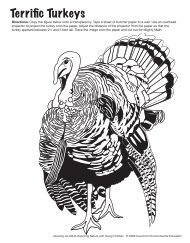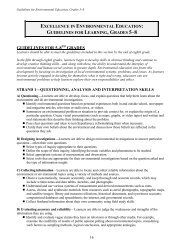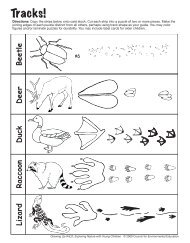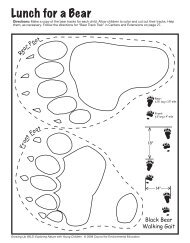Students Make Natural Connections through the ... - Project Wild
Students Make Natural Connections through the ... - Project Wild
Students Make Natural Connections through the ... - Project Wild
Create successful ePaper yourself
Turn your PDF publications into a flip-book with our unique Google optimized e-Paper software.
<strong>Students</strong> <strong>Make</strong> <strong>Natural</strong> <strong>Connections</strong> <strong>through</strong> <strong>the</strong> Integration of Social Studies and Science<br />
Susan Pass<br />
Assistant Professor<br />
University of Texas at San Antonio<br />
Department of Interdisciplinary Learning and Teaching<br />
One UTSA Circle<br />
San Antonio, TX 78249<br />
(210) 4584524<br />
susan.pass@utsa.edu<br />
Christine Moseley<br />
Associate Professor<br />
University of Texas at San Antonio<br />
Department of Interdisciplinary Learning and Teaching<br />
San Antonio, TX 78249<br />
Ph: 210.458.5992<br />
Fax: 210.458.7281<br />
Christine.Moseley@utsa.edu<br />
Brief Bios:<br />
Susan Pass is assistant professor of social studies education at <strong>the</strong> University of Texas at San<br />
Antonio. She received her doctorate from <strong>the</strong> University of Houston and currently teaches<br />
secondary social studies methods.<br />
Christine Moseley is associate professor of science education at <strong>the</strong> University of Texas at San<br />
Antonio. She received a PhD in Environmental Science from Oklahoma State University and<br />
currently teaches environmental education courses.
Abstract: This article describes a curriculum and two activities that integrate both social studies<br />
and science while inviting students to make connections between civics and science to learn<br />
significant concepts in a meaningful way. <strong>Students</strong> work within <strong>the</strong> realworld context of wildlife<br />
population scenarios, to make predictions, test <strong>the</strong>ir hypo<strong>the</strong>ses, and determine and construct<br />
graphs that best represent <strong>the</strong>ir data, while learning <strong>the</strong> importance of animal habitats and <strong>the</strong><br />
factors that impact wildlife populations in continually changing ecosystems. Discussion and<br />
experiences with charting how an environmental concern becomes a law and documenting <strong>the</strong><br />
state legislative process with <strong>the</strong> two lessons cited ensure that students understand ideas about<br />
democracy, civic leadership, and citizen responsibility.<br />
Key Words: Interdisciplinary, government, science, graphing, habitat<br />
Integration provides an opportunity for students to make natural and meaningful<br />
connections between and among multiple content areas. Both <strong>the</strong> National Council of Social<br />
Studies (NCSS 1994) and <strong>the</strong> National Science Teachers Association (NRC 1996) have long<br />
supported <strong>the</strong> integration of social studies and science with o<strong>the</strong>r content areas in order for<br />
students to make meaningful connections and to develop significant understandings of important<br />
concepts. Fur<strong>the</strong>r, both NCSS and NRC agree that it is important for students to be engaged in<br />
tasks that provide <strong>the</strong>m multiple opportunities to observe, make conjectures, hypo<strong>the</strong>size, and be<br />
encouraged to collect, organize, and describe data. Additionally, activities and lessons involving<br />
social studies and science should involve students in constructing appropriate graphs and charts<br />
to represent <strong>the</strong>ir data, making predictions and conclusions based on that data, testing <strong>the</strong>ir<br />
predictions and conclusions, and discovering what good citizenship and a democratic<br />
government can do to improve environmentalism (NCSS 1994).<br />
When we have discussed <strong>the</strong> importance and necessity of integration with preservice and<br />
inservice teachers, we are often asked <strong>the</strong> following questions: Can our students learn<br />
significant ecology while learning social studies We believe <strong>the</strong> answer to this question is an<br />
emphatic “yes” if <strong>the</strong> tasks we engage students in are chosen wisely. In this article we will<br />
<strong>Project</strong> WILD: Integrating Social Studies and Science 2
describe two lessons that integrate both civics and science while inviting students to make<br />
connections between social studies and ecology in order to learn significant concepts in a<br />
meaningful way. These lessons also integrate ma<strong>the</strong>matics. Both have been used successfully at<br />
<strong>the</strong> high school and middle school levels. We believe that <strong>the</strong>y are also adaptable for elementary<br />
school students.<br />
<strong>Project</strong> WILD, an international conservation and environmental education (K12)<br />
curriculum program developed both lessons. Both lessons incorporate <strong>the</strong> principles of wildlife<br />
management in <strong>the</strong>ir conceptual frameworks. <strong>Project</strong> WILD lessons are interdisciplinary and<br />
emphasize <strong>the</strong> importance of choice (<strong>Project</strong> <strong>Wild</strong> 2007). Since 1983, more than 940,000<br />
teachers have participated in <strong>Project</strong> WILD workshops, which have provided ecological and<br />
civics education to more than 48 million students globally (<strong>Project</strong> WILD 2007). Many of <strong>the</strong><br />
<strong>Project</strong> WILD lesson plans and information can be found on its website:<br />
http://www.projectwild.org/. “<strong>Project</strong> WILD addresses <strong>the</strong> need for human beings to develop as<br />
responsible citizens of our planet” (<strong>Project</strong> WILD 2007).<br />
The National Council for <strong>the</strong> Social Studies (NCSS) has stated that its main goals for<br />
students (besides subject mastery) are to be lifelong learners, capable of solving problems and<br />
contributing to <strong>the</strong> common good who are both critical thinkers and good citizens (National<br />
Council for <strong>the</strong> Social Studies 1994). Participation in <strong>the</strong> workshops and lesson plans of <strong>Project</strong><br />
WILD fosters all of <strong>the</strong> above – plus it educates students on <strong>the</strong> NCSS Strands of VI (Power,<br />
Authority and Governance), VIII (Science and Technology), and X (Civic Ideals and Practices).<br />
Background Information for <strong>the</strong>se Lessons<br />
The two lessons chosen for this article are adapted from two activities in <strong>the</strong> <strong>Project</strong><br />
WILD: Science and Civics, Sustaining <strong>Wild</strong>life Curriculum and Activity Guide (<strong>Project</strong> WILD<br />
<strong>Project</strong> WILD: Integrating Social Studies and Science 3
2002). Activities in <strong>the</strong> Science and Civics Guide, using both science and social studies, involve<br />
students in an environmental action project that will benefit <strong>the</strong> local wildlife community. The<br />
curriculum uses a two strand core of activities: Habitat Exploration and Participatory<br />
Democracy that prepare students to investigate a local site. The two lessons chosen for this<br />
article are representative of both strands and allow students to work within <strong>the</strong> realworld context<br />
of wildlife population scenarios, while learning <strong>the</strong> importance of animal habitats and <strong>the</strong> factors<br />
that impact wildlife populations in continually changing ecosystems. In addition, students learn<br />
how personal and societal choices made today can impact <strong>the</strong> environment in <strong>the</strong> future. They<br />
also learn to track legislation <strong>through</strong> <strong>the</strong> state’s legislative process and discover how democratic<br />
representatives can promote ecology. Discussion and experiences with students prior to this<br />
activity should ensure <strong>the</strong>y understand ideas about carrying capacity, components of habitat and<br />
limiting factors. Thus, it is advisable for teachers to invite an environmentalist in to talk to <strong>the</strong><br />
class or take a “nature walk” around <strong>the</strong> school grounds to explore animal habitats prior to<br />
engaging <strong>the</strong> students in <strong>the</strong> following two lessons.<br />
First Lesson: Habitat Exploration Limits to Living Here<br />
The major purpose of this lesson is to teach students to recognize <strong>the</strong> interdependence of<br />
ecosystem elements and <strong>the</strong> complexity of limiting factors. The law of limiting factors states<br />
that when some process, such as growth or reproduction depends on several different factors, <strong>the</strong><br />
speed of <strong>the</strong> process is determined by <strong>the</strong> slowest factor (<strong>Project</strong> WILD 2002). The slowest<br />
factor might be present in limited or overabundant amounts, such as too little light in <strong>the</strong><br />
morning or too high a temperature in <strong>the</strong> afternoon, which could impede growth or food sources.<br />
Limiting factors in nature could include temperature, light, water, salts, soil nutrients, fire, and<br />
predator and/or prey populations.<br />
<strong>Project</strong> WILD: Integrating Social Studies and Science 4
Introduction<br />
Explain to students <strong>the</strong> law of limiting factors. Give <strong>the</strong> students <strong>the</strong> following<br />
background information regarding nesting prairie falcons found in <strong>the</strong> Birds of Prey <strong>Natural</strong><br />
Area in southwestern Idaho. The prairie falcons in that area, which is <strong>the</strong> largest concentration of<br />
nesting prairie falcons in <strong>the</strong> world, nest in <strong>the</strong> late spring and early summer along <strong>the</strong> cliffs<br />
above <strong>the</strong> Snake River. For food, <strong>the</strong> prairie falcon relies mainly on an existing large population<br />
of Townsend ground squirrels, which lives on <strong>the</strong> flat land above <strong>the</strong> canyon. Availability of this<br />
prey is crucial for survival of <strong>the</strong> nesting falcons. As <strong>the</strong> summer progresses, daytime<br />
temperatures increase. Eventually, <strong>the</strong> ground squirrels go underground and hibernate (called<br />
aestivation) as a way to avoid <strong>the</strong> heat. The falcons <strong>the</strong>n move to higher elevations where <strong>the</strong><br />
ground squirrels remain active (thus, obtainable) because <strong>the</strong> temperatures are cooler.<br />
Activity<br />
o First, show students Graph A and <strong>the</strong>n ask <strong>the</strong>m to explain what happened and<br />
what caused <strong>the</strong> change in population numbers.<br />
o Show <strong>the</strong> students Graph B. Ask <strong>the</strong>m to speculate on a solution to <strong>the</strong> prairie<br />
falcon population change.<br />
o Ask students to suggest o<strong>the</strong>r physical factors that might influence wildlife<br />
activity and populations (e.g., amount of rainfall, wind speed, hours of sunlight).<br />
o Have students propose some ways that physical factors influence or limit human<br />
activity or population growth.<br />
o Investigate <strong>the</strong> competitive uses for land occupied by <strong>the</strong> prairie falcons. What<br />
happens when humans decide to create farmland or extend <strong>the</strong> city into areas<br />
<strong>Project</strong> WILD: Integrating Social Studies and Science 5
where falcons or o<strong>the</strong>r birds of prey live Do human choices impact <strong>the</strong> limiting<br />
factors of existing wildlife populations<br />
Assessment<br />
<strong>Students</strong> will write a paragraph discussing <strong>the</strong> relationships between organisms in<br />
ecosystems and <strong>the</strong> role of limiting factors in those relationships. <strong>Students</strong> will include in this<br />
essay what <strong>the</strong>y could do as concerned citizens to protect local habitats and animals.<br />
Second Lesson: Participatory Democracy – <strong>Wild</strong> Bill’s Fate<br />
The major purpose of this lesson is for students to learn <strong>the</strong>ir state legislature’s process<br />
for enacting a law that affects wildlife. At <strong>the</strong> same time, all states have state agencies that are<br />
responsible for overseeing issues involving <strong>the</strong> state’s environment and natural resources. In this<br />
activity, students will learn where to go for sources of information on <strong>the</strong> current status of issues<br />
within <strong>the</strong> state concerning wildlife. They will also learn how to track <strong>the</strong> status of a state bill at<br />
any given time in its process <strong>through</strong> <strong>the</strong> state legislature.<br />
Introduction<br />
Explain to students that state governments make legislative decisions that affect wildlife<br />
populations within <strong>the</strong> state. In addition, <strong>the</strong> responsibility for protecting and managing wildlife<br />
in any state is <strong>the</strong> responsibility of a designated state agency, governed by state laws. Explain<br />
that <strong>the</strong>re are also o<strong>the</strong>r state agencies concerned with o<strong>the</strong>r aspects of <strong>the</strong> state’s environment,<br />
such as water, land use, and air quality. The students’ state senators or representatives have<br />
offices whose staff can provide <strong>the</strong> information regarding laws governing wildlife issues and <strong>the</strong><br />
responsible agencies. This lesson will investigate <strong>the</strong> relationships between <strong>the</strong> state<br />
environmental agencies and any legislation that is being proposed as a result of <strong>the</strong>se<br />
relationships.<br />
<strong>Project</strong> WILD: Integrating Social Studies and Science 6
Activity<br />
· Appoint a team of two or three students to contact <strong>the</strong>ir state representatives or<br />
state senators to find out what bills have been introduced that would affect<br />
wildlife and/or <strong>the</strong> environment.<br />
· Have ano<strong>the</strong>r team of students contact <strong>the</strong> state agencies responsible for <strong>the</strong><br />
management of wildlife and <strong>the</strong> environment, regarding any concerns that <strong>the</strong><br />
state agencies have.<br />
· Each team is to report back to <strong>the</strong> class with <strong>the</strong>ir findings.<br />
· List <strong>the</strong> proposed legislation on <strong>the</strong> chalkboard by bill numbers, titles,<br />
amendments, and who introduced each bill.<br />
· <strong>Students</strong> <strong>the</strong>n list <strong>the</strong> concerns of <strong>the</strong> state agencies by state agencies on <strong>the</strong><br />
chalkboard and explain <strong>the</strong>se concerns to <strong>the</strong> class.<br />
· <strong>Students</strong> should <strong>the</strong>n prepare a list of questions on <strong>the</strong> proposed legislation <strong>the</strong><br />
concerns of <strong>the</strong> state agencies.<br />
· After hearing all questions, students will discuss which bill and which concern are<br />
most worthy of consideration.<br />
· Based on <strong>the</strong> concern selected, students will select a bill to investigate.<br />
· <strong>Students</strong> will track <strong>the</strong> process of <strong>the</strong> bill as it proceeds <strong>through</strong> <strong>the</strong> state<br />
legislative process. Every week, <strong>the</strong> teacher will have a student report to <strong>the</strong> class<br />
where <strong>the</strong> bill currently is in <strong>the</strong> state legislative process.<br />
Assessment<br />
<strong>Project</strong> WILD: Integrating Social Studies and Science 7
<strong>Students</strong> will write a letter to <strong>the</strong>ir state representatives or senators ei<strong>the</strong>r opposing or<br />
supporting that bill. The essay must contain:<br />
1. A concise description of <strong>the</strong> major purpose of <strong>the</strong> bill<br />
2. A discussion of <strong>the</strong> major viewpoints supporting (or opposing) <strong>the</strong> bill<br />
3. An explanation of possible unanticipatory consequences from <strong>the</strong> passage of <strong>the</strong><br />
bill.<br />
4. A description of actions that citizens might take at appropriate stages to affect <strong>the</strong><br />
bill’s passage or defeat.<br />
5. A personal statement of whe<strong>the</strong>r <strong>the</strong> writer believes that <strong>the</strong> bill should be passed.<br />
Conclusion<br />
<strong>Project</strong> WILD’s educational materials are provided to teachers <strong>through</strong> practical,<br />
interactive workshops conducted by representatives of sponsoring state wildlife, natural<br />
resources, and educational agencies. Workshop participants are encouraged to discover <strong>the</strong><br />
benefits of melding both science and social studies into useful lessons that might improve <strong>the</strong><br />
environment and certainly lead to enhanced learning among high school students. Doing<br />
interdisciplinary lessons that blend science with social studies have many useful learning goals:<br />
· Such lessons establish educational goals that require <strong>the</strong> applications of concepts, content<br />
and skills to involve students in <strong>the</strong> construction of <strong>the</strong>ir own knowledge.<br />
· These lessons engage students in tasks that challenge <strong>the</strong>m cognitively and<br />
developmentally.<br />
· Such lessons can engage students in service tasks that have clear goals and meet genuine<br />
needs.<br />
<strong>Project</strong> WILD: Integrating Social Studies and Science 8
· These lessons can maximize student voice in selecting, designing, implementing, and<br />
evaluating <strong>the</strong>ir learning product.<br />
· Such lessons promote communication and interaction with <strong>the</strong> community/state and<br />
teaches <strong>the</strong> higher thinking skills<br />
Environmental issues are complex and we need to begin sensitizing students as early as<br />
possible to <strong>the</strong> influence human behavior has on <strong>the</strong> natural world. Understanding this delicate<br />
balance between humans and <strong>the</strong>ir environment begins with developing environmental literacy.<br />
Howard Gardner’s <strong>the</strong>ory of Multiple Intelligences (Gardner 1999) states that individuals strong<br />
in <strong>the</strong> area of <strong>Natural</strong>istic Intelligence observe, understand and organize elements and patterns<br />
that are part of <strong>the</strong> natural world. Gardner (1991) also believes that natural settings provide<br />
children <strong>the</strong> opportunity to develop <strong>the</strong> understanding that education is part of, not separate from<br />
life. <strong>Students</strong> who have teachers who are knowledgeable about environmental issues, who are<br />
prepared to teach about <strong>the</strong> natural world in <strong>the</strong>ir classroom, and are excited to utilize <strong>the</strong><br />
surrounding natural areas have a strong education because <strong>the</strong>ir teachers not only create a<br />
generation of valuable citizens but <strong>the</strong>y also foster <strong>the</strong> development of <strong>the</strong> <strong>Natural</strong>istic<br />
Intelligence in those students. The way we educate students today about <strong>the</strong> environment will<br />
have a great impact on <strong>the</strong> future quality of life for generations to come. To educate students<br />
about ecology and <strong>the</strong> democratic process is fulfilling <strong>the</strong> goals set forth by both <strong>the</strong> National<br />
Council for <strong>the</strong> Social Studies (NCSS 1994) and <strong>the</strong> National Science Teachers Association<br />
(NRC 1996). Such interdisciplinary teaching should be encouraged.<br />
<strong>Project</strong> WILD: Integrating Social Studies and Science 9
References<br />
Gardner, H. “The Tensions Between Education and Development.” Journal of Moral<br />
Development, (1991): 0 (2): 113115.<br />
Gardner, H. Intelligences reframed: Multiple intelligences for <strong>the</strong> 21 st century. (New York:<br />
Basic Books, 1999).<br />
Hudson, S. J. “Challenges for Environmental Education: Issues and Ideas for <strong>the</strong> 21 st Century.”<br />
BioScience. (2001): 51 (4): 283288.<br />
<strong>Project</strong> WILD. Science and Civics: Sustaining <strong>Wild</strong>life. (Houston, TX: Council for<br />
Environmental Education, 2007).<br />
<strong>Project</strong> WILD. Welcome to <strong>Project</strong> WILD. http://www.project wild.org/ (accessed<br />
September 10, 2007).<br />
The National Council for <strong>the</strong> Social Studies. Expectations of Excellence. (Washington, D.C.,<br />
1994).<br />
National Research Council. National Science Education Standards. (Washington, D. C., 1996).<br />
<strong>Project</strong> WILD: Integrating Social Studies and Science 10
Graphs<br />
A:<br />
N<br />
U<br />
M<br />
B<br />
E<br />
R<br />
S<br />
April May June July<br />
Number of ground squirrels<br />
Number of prairie falcons<br />
B: Average Temperature<br />
T<br />
E<br />
M<br />
P<br />
E<br />
R<br />
A<br />
T<br />
U<br />
R<br />
E<br />
April May June July<br />
<strong>Project</strong> WILD: Integrating Social Studies and Science 11
Survey Says…..<br />
An informal online survey of past <strong>Project</strong> WILD<br />
workshop participants who specifically took <strong>Project</strong><br />
WILD in <strong>the</strong>ir college courses, ei<strong>the</strong>r as part of preservice,<br />
or as part of o<strong>the</strong>r courses, was completed<br />
in Ohio in December of 2006 and showed <strong>the</strong><br />
following:<br />
· 147 respondents<br />
· 86% took WILD within <strong>the</strong> last 5 years*<br />
· 67% took WILD as part of <strong>the</strong>ir methods course, 10% as part of an elective course and 18%<br />
as part of an optional offering outside of <strong>the</strong>ir classes.<br />
· 100% said <strong>the</strong>y felt it was an appropriate part of <strong>the</strong>ir courses<br />
· 75% used WILD in <strong>the</strong>ir field experiences<br />
· 76% highlighted <strong>the</strong>ir WILD training in <strong>the</strong>ir resumes or portfolios<br />
· 49% are currently teaching, of which 53% said <strong>the</strong>y currently use WILD in <strong>the</strong>ir classrooms<br />
in <strong>the</strong> following subjects**:<br />
93% in Science<br />
27% in Social Studies<br />
25% in English/Language Arts<br />
20% in Math<br />
13% in Art<br />
9% in Physical Education<br />
· 63% said <strong>the</strong>y use activities that were not part of <strong>the</strong>ir original training, meaning that <strong>the</strong>y<br />
explored and utilized <strong>the</strong> guides beyond what <strong>the</strong>y learned in <strong>the</strong>ir workshop.<br />
· 72% said <strong>the</strong>y shared WILD with o<strong>the</strong>r teachers<br />
· 99% said <strong>the</strong>y would recommend WILD to ano<strong>the</strong>r teacher<br />
<strong>Project</strong> WILD: Integrating Social Studies and Science 12
· When asked how important <strong>the</strong>y thought it was for colleges and universities to include WILD<br />
in <strong>the</strong>ir teacher education courses, <strong>the</strong>y responded:<br />
18% said it was critical<br />
45% said it was very important<br />
31% said it was important<br />
4% said it was only somewhat important<br />
1% said it was not important at all<br />
Status of <strong>Project</strong> WILD in Ohio’s 51 teacher education programs:<br />
29 (57%) have never had WILD facilitators on staff.<br />
22 (43%) have or have had at one time a WILD facilitator<br />
on staff or affiliated with <strong>the</strong>ir programs.<br />
* This was to be expected as it is very difficult to track down individuals after <strong>the</strong>y leave college.<br />
** Most respondents indicated that <strong>the</strong>y used <strong>the</strong> materials in a crossdisciplinary manner.<br />
While you may be wondering how this applies to <strong>Project</strong> Learning Tree, both programs are<br />
distributed very similarly and are utilized very similarly in Ohio. So it could be fair to say that<br />
this data could be extrapolated to include PLT as well.<br />
If you’d like to read about more of <strong>the</strong> research that’s been done on <strong>Project</strong> WILD and <strong>Project</strong><br />
Learning Tree, both <strong>Project</strong>s have past research posted on <strong>the</strong>ir national websites at<br />
<strong>Project</strong> WILD—http://www.projectwild.org/evaluation.htm<br />
<strong>Project</strong> Learning Tree—http://www.plt.org/cms/pages/21_19_4.html<br />
<strong>Project</strong> WILD: Integrating Social Studies and Science 13


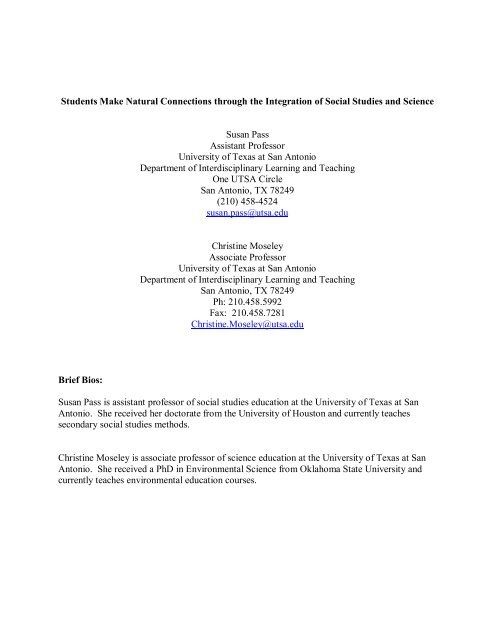
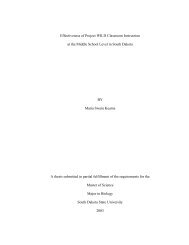
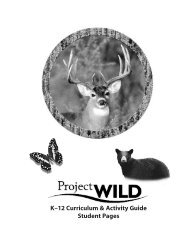
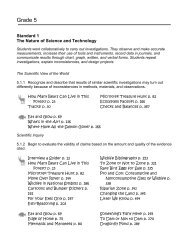
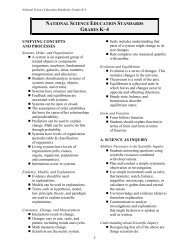
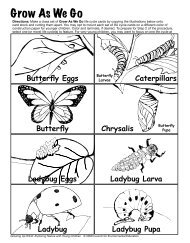
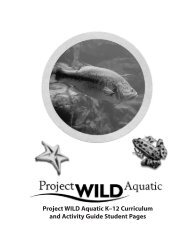
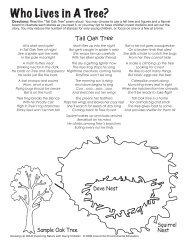
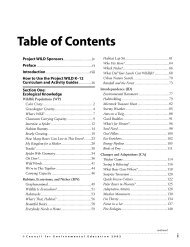
![Conceptual Framework [PDF] - Project Wild](https://img.yumpu.com/34019659/1/190x247/conceptual-framework-pdf-project-wild.jpg?quality=85)
